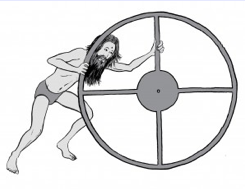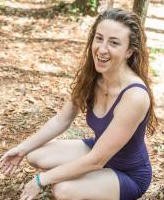A significant portion of my adult life was lived through what I will lovingly refer to as the Hot Mess Emma Phase.
I did my first yoga teacher training in Colorado with a corporate chain during this phase, where yoga was taught using a memorized script.
Moving into the Tender Transitions phase and celebrating my baby steps along the way, yoga practice and meditation have remained a powerful tool for my sanity as I stumble towards aligning with my life’s bigger purpose—even when practicing was scarce.
I finished reading a book (!). The second yoga book I have ever finished from cover to cover (the other being The Tree of Yoga by BKS Iyengar.)
I had so many “No sh*it! / A-ha! moments reading The Injury Free Yoga Practice (self published by a local chiropractor and seasoned yoga student) Steven Weiss.
With simplicity, integral movements of alignment and anatomy are broken down and sprinkled with illustrations of a cartoon Yogi. Nuggets of wisdom abound with a plethora of Yoga history served with scientific research with a steamy side of pranayama.
The Injury Free Yoga Practice is easily one of the most comprehensive and friendly books about physical yoga based in integral alignment ever written. (And I have half finished a lot of books on yoga.)
It’s simple to teach flow, but what about the transitions between postures? Aligning diaphragms along the central axis grounds allowing for truly explorative, safe and playful work.
The Cartoon Yogi from the Injury Free Yoga Practice recommends moving from the least mobile regions first.
Learning to align the spine increases the release of feel good chemicals and reduces stress on the vertebrae (very helpful for herniated/bulging discs) as well as you look sexier when you are sitting/standing well.
Aligning your spine doesn’t need to cause strain! There are a few great tricks like taking the ‘oh how wonderful’ mudra, or using the axillary (muscles around the armpit) to draw your shoulders away from your ears and drawing the middle of the throat back.
Poor alignment increases stress and reduces adrenal function but if an injured area can be exercised without pain the body’s ability to heal increases, Dr Weiss writes, “asana like the human spirit, flourishes when it remains grounded. Even birds use thermal pressures in the air as a foundation from which to soar.”
Where I teach yoga, there are 70 year olds with hip replacements (I live in Florida), yoga virgins who are prone to hyper extending their arms (I do love popping yoga cherries!) and knocked kneed individuals with swaybacks. I am learning how to teach people to align their own bodies—even how to ease back pain for those with “yoga butt” (hint: scoop the tailbone forward, scoop the breastbone and draw the navel in slightly, smile gently).
This is the book I flip through before teaching class, I bring it to my work where I see people who have endured trauma and are in much pain, the pages are marked with notes, butter stains and grains of sand.
When my students hold props in between their thighs and try to push behind them like a PEZ™ dispenser as described on page 98, to get a sense of internal rotation, I stand like a bemused dignified warrior and watch the a-ha moments roll.
The elusive and beloved psoas has its own chapter. (Did you know that in a cow the psoas is the filet mignon and tenderloin cuts of the steak?)
The psoas plays a key role in integrating the intricate relationships of the lower spine, pelvis and hips.
Can you chaturanga and not chatuwronga? (Dr. Weiss’ puns are much more clever) but seriously shoulder integration is so important to a healthy yoga practice in a world prone to rounding forward.
This book isn’t specific to any school or sect of yoga—it accounts for all of them and discloses using language and philosophy rooted in Anusara.
My best A-ha! thus far came from learning about the hyoid bone (which is in the neck) and it’s important role in alignment. Like most keys to the human puzzle, it is oh so subtle.
In seated meditation one day, I remembered to allow the muscles of the center of my neck to smile gently up towards my ears (this is where the Buddha’s smile comes from) and my spine cracked.
The really good news is you don’t need to talk about breathing into the space between the anus and the yoni/lingam to lock bandhas when your mom comes to your class. Forward tailbone scooping engages mula bandha naturally!
I’m scooping my tailbone as I write this.
Have you ever wondered why there is the sound of one hip snapping?
Structural causes of bunions?
Yoga butt?
Yoga therapy for overstretched hamstrings?
Did you know that in many cultures where people routinely carry half their body weight on the top of their head they have almost no incidence of osteoporosis even in locations where nutrition is poor?!
I wish I had had this book a long time ago, before I started massage school.
The Injury Free Yoga Practice is perfect for yoga teachers and an essential for teacher trainees. However, if you don’t have an anatomy/physiology background it may cause your eyes to glaze over / induce a brief nap for a few pages where the terms like anterior and posterior are introduced in the beginning.
A breath of fresh air to yoga in print, The Injury Free Yoga Practice offers value to the corporate hot messes and tender transition practitioners alike.
Love elephant and want to go steady?
Sign up for our (curated) daily and weekly newsletters!
Editor: Bryonie Wise












Read 2 comments and reply